How do you build a predictable, scalable, repeatable growth engine with optimal investment? That’s the big question I’ll try to answer in this article, sharing five tried and tested growth hacks from my career to date, and what it takes for a SaaS or B2B tech company to make the journey from zero to £50 million in revenue.
I'm Ashwin Krishna, I'm Head of Growth Marketing at Tact.ai, and in this article, I'm going to talk about some interesting growth hacks, and what it takes for a SaaS company or a B2B tech product company in the whole journey from zero to $50 million revenue.
Who loves trivia?
What does this graph really indicate?
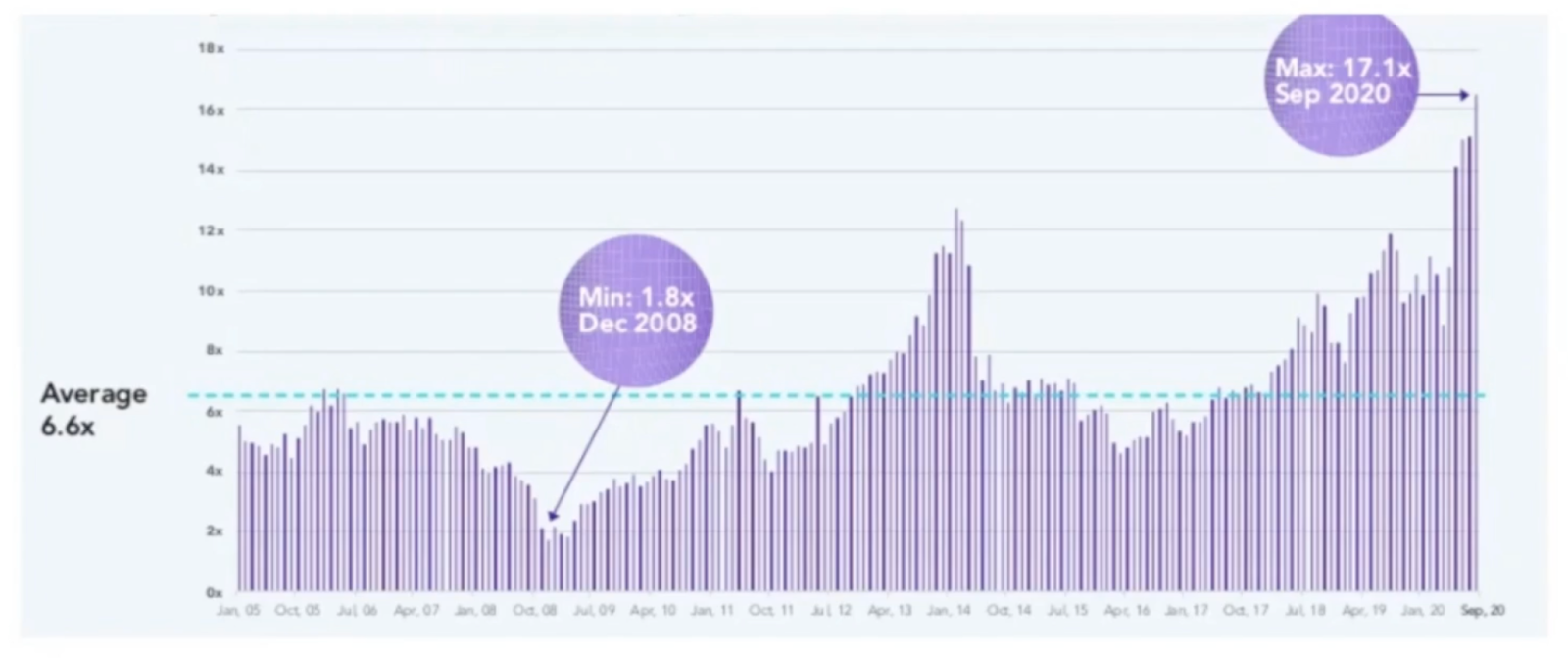
The whole world has been reeling under pressure however, the price of cloud companies has been roaring and SaaS companies have started to eat the world while the revenues are really scaling up very fast, and hence the multiples as well.
If you have $100 revenue, what's the valuation at which you're valued at? Let's say you have $100 revenue, you are valued at $1,700 considering you had 17.1 asset multiple. The bottom line is this is a great time to talk about SaaS.
Who am I?
SaaS marketer by choice and entrepreneur at heart
I am a SaaS marketer by choice and I'm proud to say I have spent almost a decade in marketing and growing SaaS companies, which are at different scales; from zero to one, one to 10, and 10 to $50 million and above and beyond.
Essentially I started as an engineer like a lot of folks did, I did a bit of programming - I was a terrible programmer back then. I have a story of two failed startups and serendipitously I found SaaS.
I have been very fortunate to work with companies like Capillary where I was able to grow the entire pipeline by almost 15 times. We as a team were able to put together a pipeline of double-digit million dollars - it's pretty significant actually.
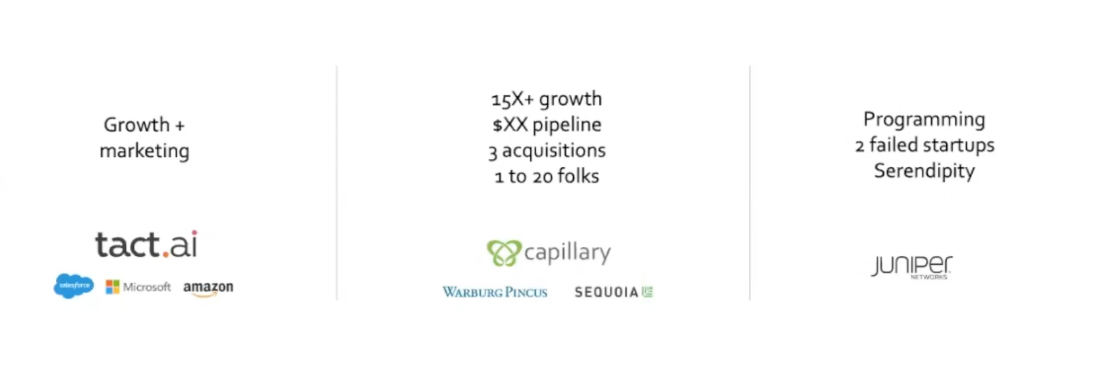
I was part of a team that got acquired by Capillary and as a team at Capillary, we acquired a couple of companies. In the SaaS world, I had the fortune of being at a company that got acquired, and I was also inside of the table where we acquired two companies so I have a bit of experience in integrating two different companies in the SaaS world.
Also, we were able to grow the team. When I joined the team we were literally no one, I had the fortune of growing the team to about 20 people and I will share a few of my learnings in this article.
At present, I work with a very interesting company called Tact.ai, which is a human-friendly CRM company focused on some of the Fortune companies. It's a CRM company, which is essentially funded by the likes of Salesforce, Microsoft, and Amazon besides some of the institutional investors.
How do you build a predictable, scalable, repeatable growth engine with optimal investment?
The big question I'll try and answer is, how do we really build a growth engine which is predictable, scalable, repeatable, and also sustainable when it comes to investment?
Especially when you're a small company or at a growth stage, you have zero or no money. Either you have a little money, or you just don't have money. How do you really build a system which essentially helps the company to grow predictably, which will help the company to grow fast and at a scalable pace?
The agenda
First up, I'll share a broad framework that I call the 10X growth framework, again, based on my learnings.
Next, I'll share five different actionable hacks or frameworks that have worked for me, in my experience.
The 10X growth framework
In a nutshell, this is about slicing the entire set of growth strategy into three different phases considering you're growing from zero to one, one to 10, and then $10 million and beyond.
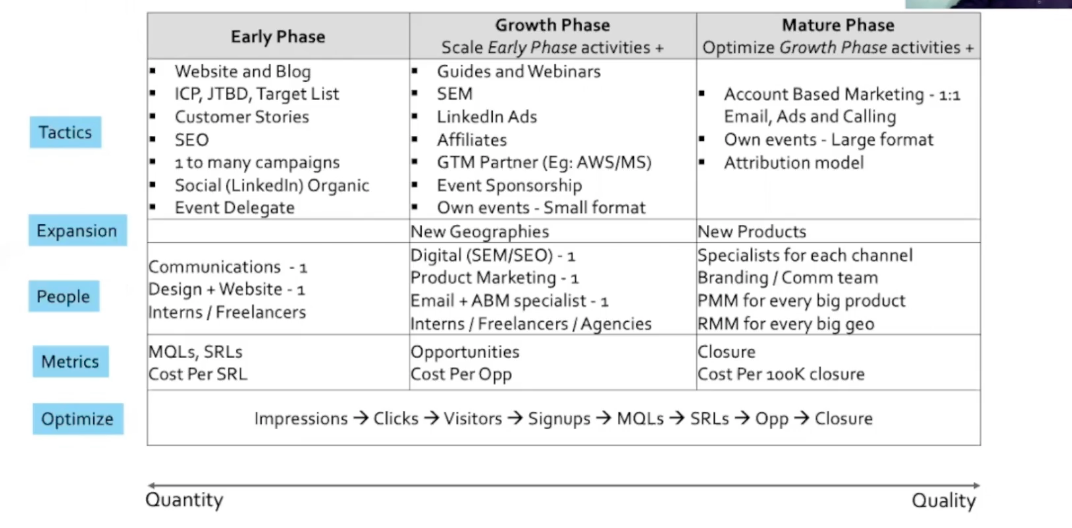
Early phase
Early phase is where you have very little or no money, you don't have a team, you're just trying to figure out building a website and a blog, you're trying to figure out the ICP (the ideal customer profile), the JTBD (the jobs to be done).
All of these frameworks will help you to figure out who is the best person, the best customer, the best set of customers you want to go after and what type of messaging you want to propagate. Things such as customer stories are very important in this phase.
Challenges such as search engine optimization are a real deal here because SEO will take a lot of time to build. Hence you've got to lay the foundation when you're just getting started.
The other thing I want to touch upon is one-to-many campaigns, I am not going to talk about the mass campaigns where you will send every message to every person in the world, that just doesn't work. A one-to-many campaign is the starting point.
This is a phenomenon where you take a couple of categories, a couple of industries, you understand why your product is the best suited for those industries and you essentially figure out the pain points of that industry, string a storyline which is suited for that industry, and you essentially talk to all the folks in that industry actually.
Let's say you're an ERP company and you are going to launch a campaign which is for BFSI. Take into consideration the challenges the BFSI industry goes through, not a generic story. This one-to-many campaign, for a specific industry, works beautifully well, especially when you're in an early stage.
Other things include you're also trying to build the community, LinkedIn would typically be the number one channel, the idea is to really focus on building the community by maximizing the content you generate. Content that is great, useful, relevant, and fresh. This is what you typically do in the early phase.
Growth phase
Let's say you have money, you have maxed out on some of the channels such as SEO and one-to-many email campaigns. This is when you build a very structured content generation framework and also start investing in channels such as SEM and LinkedIn.
SEM is super targeted and has a lot of buying intent. With LinkedIn, the idea is to take one category, one industry, one country, one persona and then run a bunch of ads and optimize accordingly.
You also have to figure out a GTM partner, especially if you're a SaaS company, you would be obviously hosted on AWS or Microsoft Azure so try and find that cloud partner or another GTM partner who can help you essentially get leads, meetings, and whatnot.
Mature phase
In the mature phase, it's all about how do you really launch a one-to-one marketing framework?
This is where you figure out the top 50 accounts, what exactly each customer and each individual interests are, try and talk to them in a way that is relevant for them.
The growth phase is the phase where you are grappling to figure out what the different geographies you want to really invest in are and the mature phase is where you have possibly figured out a few markets and maybe one product and this is a phase where your company is possibly pivoting into a multi-product company.
This is a place where you would have a matrix where you have, for example, geographies in rows and products in columns, and try to figure out what product would work really well in a specific geography, and spin the GPM, which is a multi-product, multi-geo type of stuff.
If you ask me who the two people are you should hire, especially when you're in a starting place, one is a great comm or content person who has a knack for understanding numbers as well. The second person is a full-stack designer and website person, I'm not a big fan of outsourcing anything which is called marketing and growth.
Hence the whole idea is to insource, do everything internally and possibly outsource some of the things such as vision videos such as customer stories which really requires a lot of creativity and out-of-the-box thinking.
The difference between an early phase and a mature phase in terms of this broad-spectrum is in the early phase, you'll be focused on quantity, and in the mature phase, it is all about quality. In the early phase, you will be generating tonnes of leads, which might not matter. But in the mature phase, it's all about generating leads, which essentially close.
Five actionable hacks/frameworks
1:1 marketing/account-based marketing
Dimensions
This framework will help you figure out what the different dimensions you should research while writing an email or sending an email or a display ad are. Dimensions such as:
Regional insight for the sector
- What region do you want to cater to?
- What region do you want to run the campaign to?
- What company do you want to target?
Company
Let's say there's a company x, you have to figure out:
- What revenue do they have?
- What are the goals and the objectives or the top five priorities of that company?
- What are the awards they win?
- What is the type of products they use?
Technographics
Going back to the same ERP example. If you're an ERP for a BFSI industry, you're talking to a specific bank so try and figure out:
- What ERP do they use?
- What version of the ERP do they use?
- When is the renewal coming?
- What is the ARR they're essentially paying?
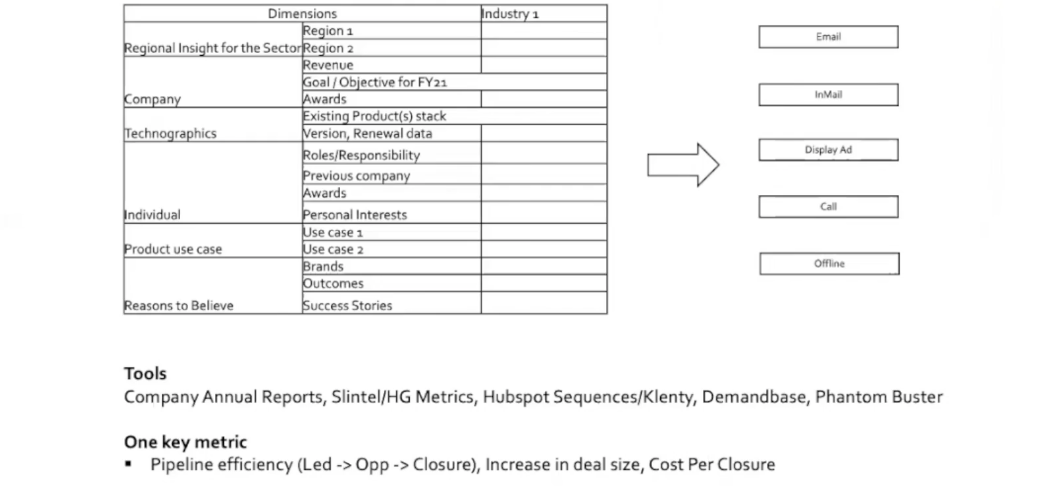
You can find out all of this information using tools such as HD insights, or Slintel - there are a bunch of tools you should exploit.
Individual
Then comes individually, talking to a specific person, find out what hours they're working, what their interests are, through social networks, such as Facebook, and find out what previous companies they worked for, and so on and so forth.
Product use case
Next, if you're talking to a specific industry and a specific company, what is the product use case you want to talk about? Let's say you're talking to a bank that’s already using a big monolith ERP, where you can't get into.
But if you had a module, or a use case that can truly solve, which can sit on top of the existing ERP you want to use that as a foot in the door, focus on that use case.
Reasons to believe
Reasons to believe is all about what type of customer stories you want to share with that specific prospect, which will help you get through the door.
Tools
In a moment, I'll tell you how to use this data in the form of ads or emails but before that, there are a bunch of tools you can use:
- The company annual reports if it's a listed company to find out these insights,
- Slintel and HG Metrics to find out the technographic information
- Klenty or HubSpot sequences to send small batches of emails so the deliverability rates and open rates are very high. Or
- You can use my favorite tool here which is Phantom Buster, a full-stack growth hacking automation stack that'll help you automate a bunch of things. It's a beautiful platform, please go and explore that.
One key metric
There's one key metric that would essentially influence ABM. The one key metric is really how well your account-based marketing will influence your pipeline closures and is very important. Let's see an example.
An example of ABM for a multiplex account
This is an email that has been written based on the framework I just went through.
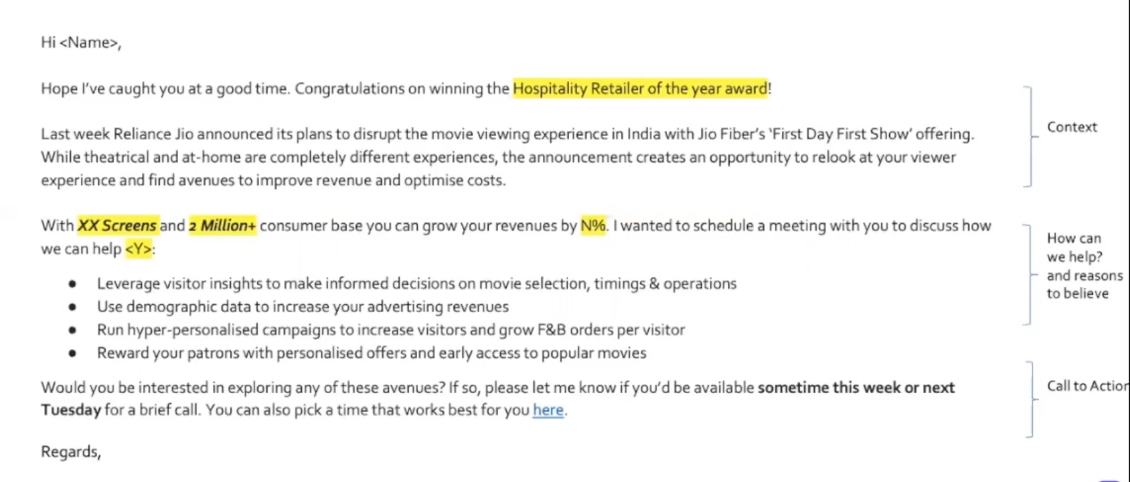
There is an award which this individual has won so we added this in the first line saying "congratulations for winning the award".
There are a bunch of dimensions in yellow which are all about this multiplex. You can see the structure, there are three different components to it.
- One is the context - this is where we address or talk about a problem. Here we're talking about Jio which launched last year.
- The second section is all about the solution you as a company can deliver.
- Finally, you have a call to action.
This is a winning template that has really worked in the email or ABM scenario.
2. It’s time to look at the full-funnel view
Most marketers focus only on the top of the funnel, all they care about is getting a bunch of meetings for the sales guys. People don't worry a lot about figuring out whether those meetings are real, whether these meetings really got converted into a real opportunity, they forget the closures, upsell and cross-sell.
It's high time we look at the full funnel, and this is the full funnel for SaaS.
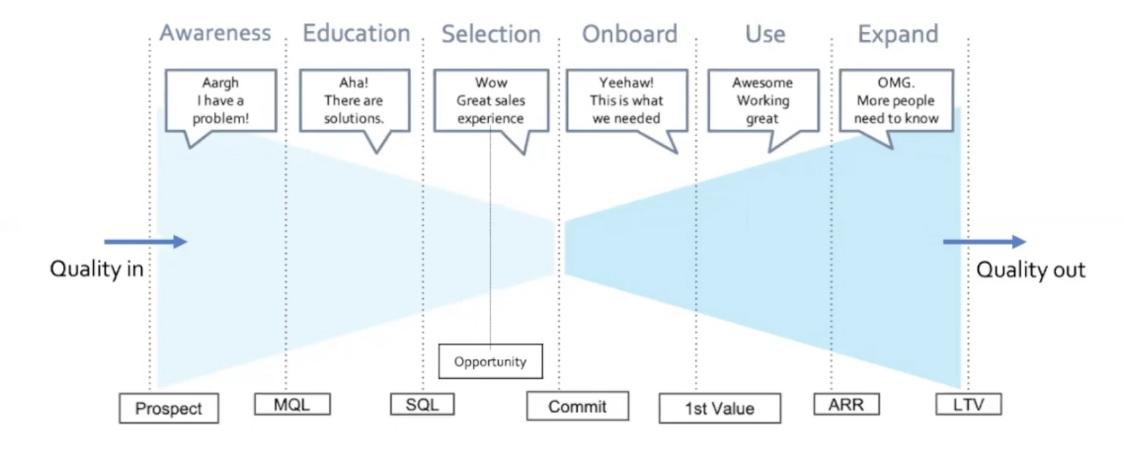
It is not something that would end in closure and commit, the funnel would get extended until you're figuring out how do you increase the lifetime value of the customer?
I'll show you a simple example, this has multiple stages but I’ll focus on one in particular.
Example: MQL-SQL conversions
There's a prospect who will come and sign up, becomes an MQL, becomes an SQL, so on and so forth. I'll show one example, one hack, which has really helped us.
This hack is all about how to automate a set of content pieces and a set of communications for MQLs who are highly qualified but they're not converting into an actual meeting. This is the workflow...
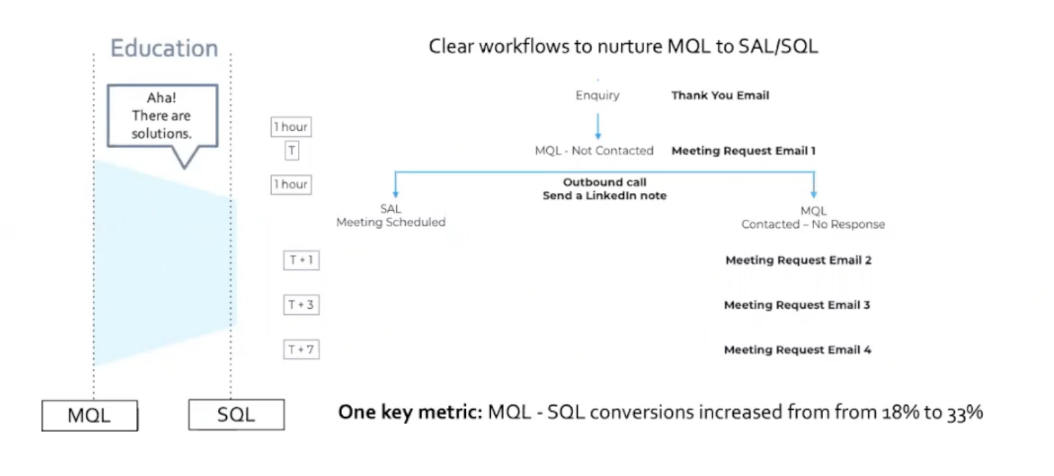
A lead would come in, you send a thank you email, and then after some time, the moment the MQL is assigned to the salesperson, you will send an automated meeting request email from that salesperson.
You wait and watch, there is no meeting been set up. After two days, you essentially send a follow-up email, automated, where you send a good content page saying "Hey, thanks for signing up. Looks like you're busy. Let's connect, please let me know what time. Meanwhile, here's a content piece which might be helpful."
On the same lines, you try three or four times, you have your BDR rep to do an outbound call as well, you also ask the BDR rep to do a LinkedIn outreach so it becomes a holistic omnichannel touch base.
One key metric
When we did this whole exercise, we were able to convert or increase the MQL to SQL, this conversion rate, from 18 to 33, which is a massive number.
3. Cracking the social code
How do you really crack the code of LinkedIn? Unfortunately, most companies, especially early stage, don't grow beyond sending festival wishes on LinkedIn and also putting a bunch of posts that would be liked by their employees.

Story buckets
To grow beyond this phase to a point where relevant people should start liking and engaging with your posts, you've got to put out content that is bucketed into different categories.
- Industry content - which is all about your point of view about your industry, which is useful for your audience.
- Company and product content is very straightforward - it's all about your product and your company.
- People stories about your employees, something unique about them, featuring them.
- Customer service is all about making your customers the heroes.
- Contextual stories is very interesting and important. I'll give you an example.
Example: contextual stories
At Capillary, we were focusing on the retail industry, and interestingly, in the month of December, there is a day which is dedicated for retail store staff, the frontline staff, the person who's out there for 10 hours every day and still smiles at the end of the day, providing a great service.
More often than not, they're ignored so we said let's thank them because they are one of our product users. We said this is a great day or moment to thank them. We actually did a story to uncover the life of a retail worker and what that looks like, e.g. what their day looks like, 12-hour shifts, most of the time it's a thankless job, etc.
Then we said "Hey, can we take a moment to thank them? Can we all pledge to take a moment to thank them whenever we go to a store after we've completed a transaction, or somebody gives us a suggestion? Let's thank them that in this video".
We invested $100 to create this video, our internal team did the storyboarding and the recording, we had a freelancer who did the editing, it took about $50. We put it out on LinkedIn and ensured all our customers, all our employees, all our community folks were sent this.
We were able to reach out to more than 20,000 relevant people with $0 spending for the channel. All the money we spent was creating the content. So contextual content is very, very important and you need to focus on that.
Decoding what LinkedIn loves
Again, I referenced the LinkedIn video example, you've got to really understand how LinkedIn works. LinkedIn works when somebody clicks on 'see more', the more often that happens the more brownie points LinkedIn will give you. So you'll get more brownie points where you have engaging native video content. Try and monetize those things.
Let your leadership team share their POV
The most important thing is to let your leadership team share the point of view. As a small company, you might have a couple of 100 followers, but your leadership team will have maybe 10s of 1000s of followers if they're very active on LinkedIn.
Ensure you help the leadership team to share the point of view about the industry and automatically their network will get activated who in turn will come and start following the company and then, in turn, it will offer you free brand equity.
Tools
Again, I will go back to tools such as Phantom buster, which is amazing, and then Publer a tool that will help you essentially schedule your social posts.
One key metric
Relevant followers, which you should track.
The most important thing is don't track all followers on your company page, go and figure out what sub-category of the audience are the relevant followers. Try and track that number, that's important.
Framework to put a method to content madness
How do we put a method to the madness for content?
Inputs from sales and customer success + Google Adwords & SEM Rush
The number one point is to really work with the sales team to get their inputs on what type of topics are right based on their analysis. Spend time on Google Adwords, spend time on SEM Rush to find out keywords that have high volume and low competition - that's one input.
The moment you have this set of topics, you package it in a way where you - in a very structured way - will put together if you want to create content that's top of the funnel, middle of the funnel, or bottom of the funnel.
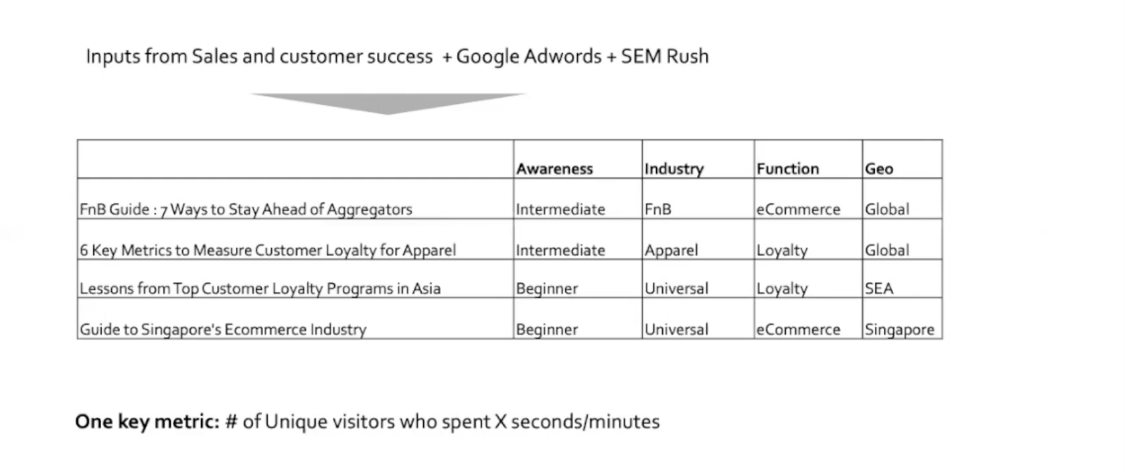
You'll also figure out the type of people you want to cater to.
- Do you want to cater to people who are at the beginner stage, for instance, somebody who is an analyst?
- Or do you want to cater to managers who are at an intermediate stage in terms of the hierarchy and standing?
- Or do you want to build content that essentially addresses the CXOs?
- What industry do you want to talk about?
- What function or what product do you want to pitch?
- What product do you want to focus on by doing reverse engineering?
- What do you want to talk about?
This is a framework we use, it's very extensive in nature but I've tried to consolidate this in one image. It all starts with getting the right sources to find out what type of topics you want to write, then cleanse the set of topics, package and structure it in a way where we can be very sure that this is the type of content we are writing.
One key metric
The most important metric is - what is the number of unique visitors who are spending or consuming content in an organic way?
Most importantly, how much time they really spend. It doesn't matter if somebody comes and just bounces out - that is not the metric we want to track. We want to track the number of unique visitors who possibly spend 30 seconds, one minute, or two minutes, depending upon the length of the content.
Getting customer story approvals
Getting customer story approval is super difficult. One thing that's worked for us is this framework.
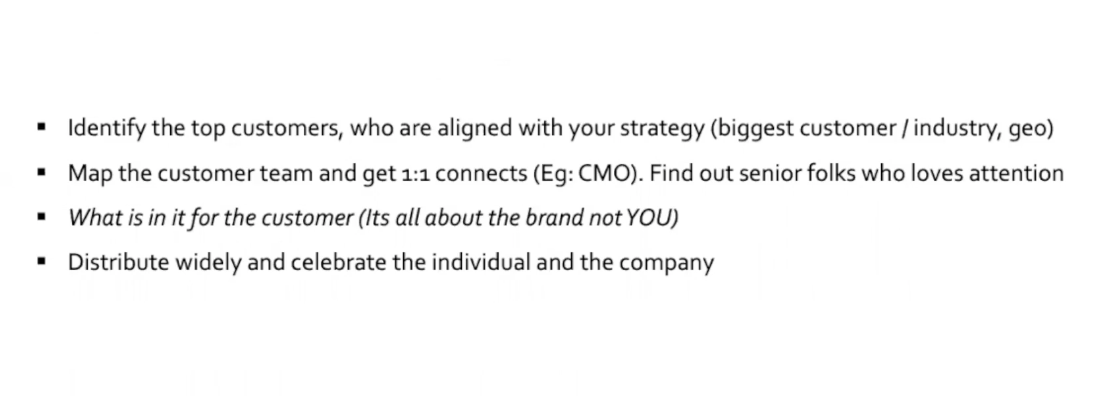
Identify the top customers, who are aligned with your strategy
We used to spend a lot of time identifying the top customers, who you want to get a story from. It can be the biggest customer you have, it can be the customer who is in a specific industry or specific geography.
Map the customer team and get 1:1 connects
Once you have the place, very structurally put all of them in one place, and try and figure connections. Speak to a customer success person, speak to a salesperson, go and find out on LinkedIn, build a connection with those individuals, with your buyers, especially, people who are really at the top.
You as a marketing person, get a one to one connect. Because customer success people can only help you to a certain extent, you are the person who should go and tell them, pitch them, what is in it for them.
What is in it for the customer
This is the most important point which a lot of brands forget, they go and shoot a video blind which is all about their product and it just doesn't work. Go and figure out a way to tell a story from the point of view of your customer.
What are the challenges they face? How did they become a hero? How they became a hero is the value proposition. When you take this value proposition of, "Hey, customer, we are planning to do a video in which we will cover how you became a hero" they will be very happy, they'll be possibly the happiest people to accept.
Distribute widely and celebrate the individual and the company
Obviously, it's not as easy as I'm telling you but if you follow this structure where you map the customers, do the mapping in terms of whom you want to speak, go and pitch them as an individual from the marketing team, and then go and distribute.
Distribute the hell out of this content so that they become famous, and you, in turn, become famous.
Find senior folks who love attention
The most important thing here is finding the people who love to speak because a lot of people are introverted and they will just say no. The company will not approve it because they have other reasons as well, because they just don't like to speak.
Find the senior folks who love attention and are also a decision-maker, be very persistent, and talk from their point of view. Explain how this whole initiative will not only help the relationship between you and them but also it's an opportunity to talk about their brand.
Bonus hack: the rule of 10%
As a marketing team and growth division, we spend a minimum of 10% of our time in the field talking to salespeople, customers, and prospects.
This one simple hack of spending a minimum of 10% of our time listening to calls, BDR calls, doing cold calls ourselves, attending the QBR meetings was invaluable.
Our customers used to give us a hell of a lot of information about the industry, what is happening, what the customers are wanting, what the customers don't want, etc.
Thank you.



